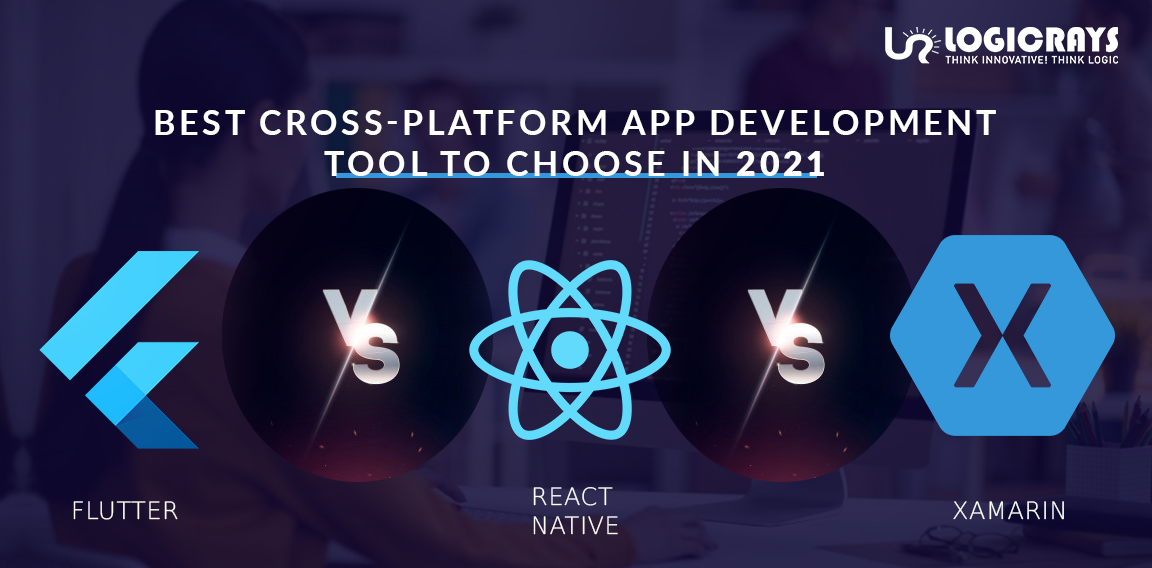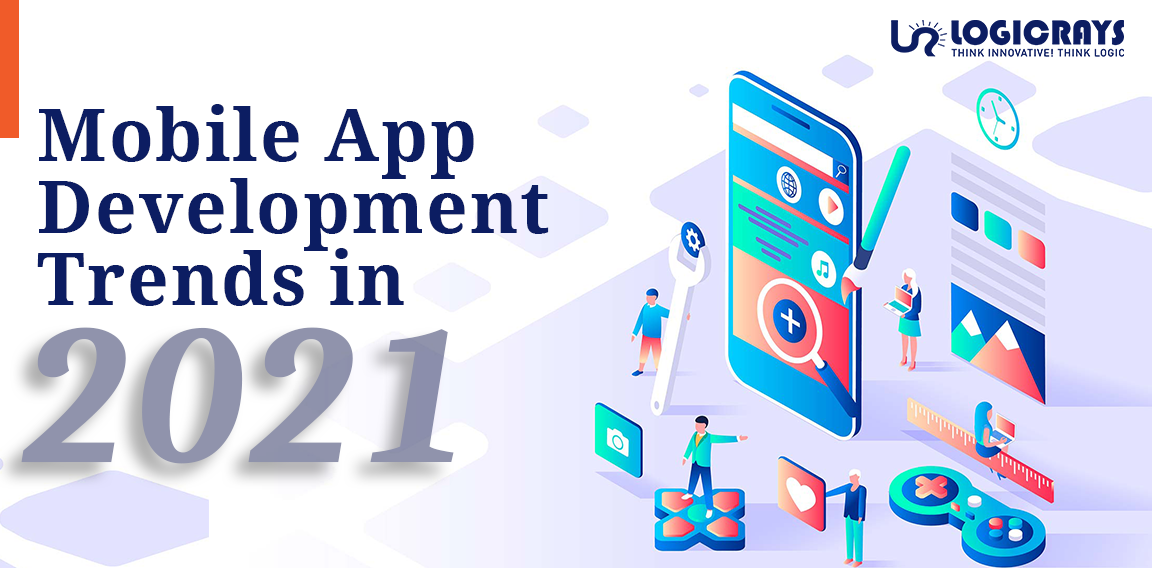A sharp spike in Mobile app development after Covid-19 Pandemic took place; the usage of cross-platform app development tools has increased. A large number of Mobile App Development Companies are interested in using cross-platform technologies.
There is no way that mobile apps developed on cross-platforms can match the level of native mobile apps when it comes to their performances.
“Choosing a Mobile Development Framework is Hard” – By Most Developers
Native Platform is good but there are mainly two issues that developers face with native mobile development: Consistency and Cost. But for better mobile app development; cross-platform frameworks already exist in the market that give solutions to both problems.
Let’s have a look at all top cross-platforms and sort out your choice here and answer the question “Which cross-platform mobile app development will you choose to create the best Application?
When making your first app, it can be difficult, it can be daunting to decide from all the different options that are available for use for the mobile app framework. It makes it tough, it’s not easy. There is a lot of information out there, that can lead us to a good path or a bad path. On top of that, there’s a lot of considerations outside of the framework that impacts our app as well.
Let’s take a look at the considerations first.
Considerations
These are some points that you should keep in mind while choosing the best app framework for development.
- Development Costs
- Hire an Appropriate Engineer
- Maintenance Cost
- App Performance
- Features Required
- 3rd Party Risks
Flutter vs. React Native vs. Xamarin

The Cross-platform frameworks for mobile app development are in a lot. These platforms allow us to still create a totally native app that gives us access to every single iOS and Android API.
Every framework has its pros and cons, but here I have mentioned some of the best mobile app development frameworks that are very popular among developers for their particular functionalities. Those frameworks are Flutter, React Native and Xamarin.
Let’s start going through every framework one by one.
Flutter
Flutter allows for the rapid and simple creation of cross-platform mobile app development. You do not need to build different iOS and Android apps. What you need is a single codebase to support both platforms.
Flutter consists of two important parts in it:
#1 SDK (Software Development Kit): A selection of resources that will aid you in the creation of your applications. This includes compilers and tools for compiling the code into native machine code.
Flutter is Google’s mobile app SDK, which includes a framework, widgets, and tools to make it simple for developers to create and deploy visually appealing, fast mobile apps on both the Android and iOS platforms.
#2 Framework: A collection of reusable UI elements text inputs, buttons, sliders, and so on. You can use this to customize in a way that fits your needs.
Flutter’s programming language is Dart, which is an unusual choice given that it is not well-known. If your developers haven’t worked with Flutter before, they’ll most likely have to learn Dart on top of Flutter. However, that isn’t too hard to do as it is pretty similar to JavaScript. It should be noted though.
One of the major issues for cross-platform developers using Xamarin and React Native was the lack of support for customizing native UI components, which are used internally in both frameworks.
Since native libraries and code can be incorporated with Flutter applications, some iOS / Android knowledge is needed. The same three-language issue, requiring developers to be proficient in three technologies at the same time.
Since Flutter is written almost entirely in Dart, developers would have a difficult time migrating Flutter projects to other cross-platform frameworks or native applications. All would have to be rewritten from scratch.

Why and When to use Flutter?
It is clear that Flutter is not yet mature enough to manage more complex projects. At the same time, it’s a nice option for an MVP (especially for startups). Actually, this is a general trend for all emerging technologies.
Essentially, if you have an idea for a mobile app but aren’t sure if it’s a good one, create your MVP with Flutter to save money and see your idea in motion. If the MVP is a success, you should consider “turning it” into native mobile apps instead.
Let’s face it: creating two different apps from the beginning will require significantly more time and resources. This is also one of the reasons why startups with limited capital choose cross-platform solutions such as Flutter. Reusing code allows them to bring their innovations to life without having to make large investments.
Pros & Cons of Flutter
Pros
- Quick Compilation
- Simple and Easy to learn
- Easy to use
- Ideal option for startup MVPs
- Large Community
- Supported by Android Studion & VS Code
- Hot Reload (used for making changes in code)
- Fast Rendering
Cons
- Not Mature
- Apps are quite large and heavy to start
- No guidelines being followed
- Weak iOS features support
- Lack of Password manager support
React native
React Native extends the React approach to mobile. A single JavaScript codebase (UI and business logic) is written and then compiled into native apps.
React Native is Facebook’s cross-platform. Facebook and the open-source community actively support technology. The Android and iOS SDKs are wrapped and exposed to JavaScript in the same way that Xamarin is. However, because of their popularity, there are many more actively supported third-party libraries.
In this, you get faster development speed because again, here, you have to write the code once and it will run on both iOS and Android Platforms. Also, the maintenance cost is low because once the code is fixed, you won’t have to worry about it ever again.
There is no easy way out once you’ve decided to use React Native for your project. A complete rewrite will be required to migrate to other cross-platform frameworks or native mobile apps.
If you’ve worked with React before and want to get your team up and running quickly with a mobile app, React Native is a best option.
You can recruit a couple of senior developers to assist you in writing native and bridging code, you can put together a fairly good mobile team. If not, you will become dissatisfied because what is given out of the box for React Native is not feature-rich or feature-complete. This will leave you scouring the internet for open source solutions from third parties, which could be hit-or-miss in terms of quality or growth.
React Native is fine, and it has the potential to be great, but it has yet to deliver on the promise of having a single codebase to rule them all.

Why and When to use React Native?
The primary advantage of using React Native is the ability to share code between iOS and Android rather than writing and maintaining two entirely different codebases. Aside from that, you can reuse portions of your web app. You can share even more code between the three platforms if you use React Native Web. Perhaps the whole thing.
Another advantage is that app updates are delivered more quickly. The app review process is not needed for your app. Instead, you can use Expo or CodePush to perform over-the-air (OTA) updates (except while updating native code).
Pros & Cons of React Native
Pros
- Common codebase
- Shorter Time for Marketing
- Easy to learn for developers
- Fast development with Hot-Reloading
- Open Source
- Faster Performance
- Possesses Stability
Cons
- Navigation is not smooth
- Hiring an Expert is necessary
- Difficulties in Renewing License
- Not All APIs are supported
- Less Third-Party Libraries
Xamarin
Xamarin is Microsoft’s cross-platform native solution that we build in visual studio using programming languages (.Net, C#, and F#). It was founded in 2011 and then in 2016, Microsoft acquired it. Xamarin has created an open-source C#-based platform that enables the development of mobile apps for Android, iOS, and Windows Phone from a single codebase.
The UI and UX are totally native and come with fast development speeds because you would be writing in one language, so you don’t have to rewrite it like other first-party toolsets.
Its performance is just as high and fast just like the coding in Xcode and Android Studio.
Xamarin is one of the best cross-platform mobile app development tools because it is a mature technology, it has been around for over a decade, and it’s feature-complete, meaning every time Apple and Google release an update; Microsoft will release those same updates in Visual studio. Also, it’s open-source.
The vast majority of iOS and Android SDKs are wrapped and accessible via C# client code. Considering this case of lacking features native code and native libraries can be combined with Xamarin applications; however, this allows the developer to have Android or iOS expertise, which is rarely the case.
On other hand, for C# developers interested in developing mobile applications, Xamarin is an obvious alternative. Xamarin apps often provide a satisfactory experience for customers, developers, and users in small-term projects.
Written code is difficult to adapt to native mobile applications or other cross-platform frameworks. As a result, once selected, Xamarin must be used for all project functionality.

Why use Xamarin?
Xamarin – Forms will accept your Xamarin. Native abilities even more, but there are moments when it makes more sense than others.
Using Xamarin to create mobile applications allows programming more powerful and cost-effective while retaining all native app functionality. However, this is not a one-size-fits-all solution.
In several instances, we’ve discovered Xamarin to be a successful tool that significantly reduces both creation and maintenance costs without sacrificing efficiency.
As a result, we believe it has the potential to be a game-changer for many.
Nonetheless, Android and iOS continue to dominate the mobile industry, and you must balance the benefits and drawbacks of native vs. cross-platform growth while deciding on the quickest, simplest, and most effective way to create your solution.
Pros & Cons of Xamarin
Pros
- High Performance
- Continuous Developers Support
- Flexible with C#, F#, and . NET.
- Quick GUI Prototyping
- Rapid Mobile App Development (RMAD)
- Easy Code Maintenance
- Code Reusability
- Cost-Effective
Cons
- Small Community
- Larger app size
- Limited access to Open Source Libraries
- Delayed SDK and API support
Folding Up!
Consider using Flutter or React Native if you are starting from scratch and want to ship a POC (Proof of Concept) or MVP (Minimum Viable Product) as soon as possible. However, be prepared to face technological limitations and still be a few steps behind the market, or rewrite mobile apps using native technologies.
If you already have native mobile apps or want to get the most out of native mobile platforms, consider using the platform according to your choice and requirement, which takes almost no effort from the Android developers but can save a significant amount of time on the iOS side. In the worst-case scenario, you actually reimplement the failed shared element in Swift, with no obligations.
When it comes to the time and expense of developing mobile applications, none of the cross-platform systems have an official statistic. However, if we consider the effort required to create two different native mobile applications to be 100%, any of the solutions outlined in this article can save up to 30% of your team’s time consumption while depending on the complexity of your project.










